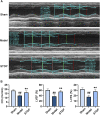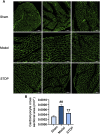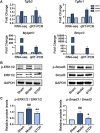Shexiang Tongxin Dropping Pill Protects Against Chronic Heart Failure in Mice via Inhibiting the ERK/MAPK and TGF-β Signaling Pathways
- PMID: 34925046
- PMCID: PMC8682969
- DOI: 10.3389/fphar.2021.796354
Shexiang Tongxin Dropping Pill Protects Against Chronic Heart Failure in Mice via Inhibiting the ERK/MAPK and TGF-β Signaling Pathways
Abstract
Background: Chronic heart failure (CHF) is a major public health problem with high mortality and morbidity worldwide. Shexiang Tongxin Dropping Pill (STDP) is a widely used traditional Chinese medicine preparation for coronary heart disease and growing evidence proves that STDP exerts beneficial effects on CHF in the clinic. However, the molecular mechanism of the therapeutic effects of STDP on CHF remains largely unknown. Objective: This study aimed to elucidate the mechanism of action of STDP against CHF by integrating network pharmacology analysis and whole-transcriptome sequencing. Methods: First, the mouse model of CHF was established by the transverse aortic constriction (TAC) surgery, and the efficacy of STDP against CHF was evaluated by assessing the alterations in cardiac function, myocardial fibrosis, and cardiomyocyte hypertrophy with echocardiography, Masson's trichrome staining, and wheat germ agglutinin staining. Next, a CHF disease network was constructed by integrating cardiovascular disease-related genes and the transcriptome sequencing data, which was used to explore the underlying mechanism of action of STDP. Then, the key targets involved in the effects of STDP on CHF were determined by network analysis algorithms, and pathway enrichment analysis was performed to these key genes. Finally, important targets in critical pathway were verified in vivo. Results: STDP administration obviously improved cardiac function, relieved cardiomyocyte hypertrophy, and ameliorated myocardial fibrosis in CHF mice. Moreover, STDP significantly reversed the imbalanced genes that belong to the disease network of CHF in mice with TAC, and the number of genes with the reverse effect was 395. Pathway analysis of the crucial genes with recovery efficiency revealed that pathways related to fibrosis and energy metabolism were highly enriched, while TGF-β pathway and ERK/MAPK pathway were predicted to be significantly affected. Consistently, validation experiments confirmed that inhibiting ERK/MAPK and TGF-β signaling pathways via reduction of the phosphorylation level of Smad3 and ERK1/2 is the important mechanism of STDP against CHF. Conclusion: Our data demonstrated that STDP can recover the imbalanced CHF network disturbed by the modeling of TAC through the multi-target and multi-pathway manner in mice, and the mechanisms are mainly related to inhibition of ERK/MAPK and TGF-β signaling pathways.
Keywords: ERK/MAPK signaling pathway; Shexiang Tongxin dripping pill; TGF-β signaling pathway; chronic heart failure; network pharmacology; whole-transcriptome sequencing.
Copyright © 2021 Zhang, Liu, Fang, He, Lu, Wang and Fan.
Conflict of interest statement
Author QF is employed by the Inner Mongolia Conba Pharmaceutical Co., Ltd. HH is employed by the Zhejiang Conba Pharmaceutical Co., Ltd. The remaining authors declare that the research was conducted in the absence of any commercial or financial relationships that could be construed as a potential conflict of interest.
Figures






Similar articles
-
Protective effects of Shexiang-Tongxin dropping pill against acute myocardial infarction in rats through inhibition of apoptosis and ERK/MAPK signaling pathways.Heliyon. 2024 Oct 29;10(21):e39939. doi: 10.1016/j.heliyon.2024.e39939. eCollection 2024 Nov 15. Heliyon. 2024. PMID: 39553562 Free PMC article.
-
Shexiang Tongxin Dropping Pill Allieviates Heart Failure via Extracellula Matrix-Receptor Interaction Pathways Based on RNA-Seq Transcriptomics and Experimental Studies.Chin J Integr Med. 2023 Jul;29(7):600-607. doi: 10.1007/s11655-023-3633-0. Epub 2023 Mar 26. Chin J Integr Med. 2023. PMID: 36971884
-
[Mechanism of Shexiang Tongxin Dropping Pills in treating diabetic cardiomyopathy based on network pharmacology and animal experiments].Zhongguo Zhong Yao Za Zhi. 2024 Apr;49(7):1905-1914. doi: 10.19540/j.cnki.cjcmm.20231127.401. Zhongguo Zhong Yao Za Zhi. 2024. PMID: 38812203 Chinese.
-
Mechanism of action of non-coding RNAs and traditional Chinese medicine in myocardial fibrosis: Focus on the TGF-β/Smad signaling pathway.Front Pharmacol. 2023 Feb 9;14:1092148. doi: 10.3389/fphar.2023.1092148. eCollection 2023. Front Pharmacol. 2023. PMID: 36843918 Free PMC article. Review.
-
Qili Qiangxin (QLQX) capsule as a multi-functional traditional Chinese medicine in treating chronic heart failure (CHF): A review of ingredients, molecular, cellular, and pharmacological mechanisms.Heliyon. 2023 Nov 8;9(11):e21950. doi: 10.1016/j.heliyon.2023.e21950. eCollection 2023 Nov. Heliyon. 2023. PMID: 38034785 Free PMC article. Review.
Cited by
-
Network Analysis and Experimental Verification of the Mechanisms of Hydroxysafflor Yellow A in Ischemic Stroke Following Atherosclerosis.Molecules. 2023 Nov 28;28(23):7829. doi: 10.3390/molecules28237829. Molecules. 2023. PMID: 38067558 Free PMC article.
-
Protective effects of Shexiang-Tongxin dropping pill against acute myocardial infarction in rats through inhibition of apoptosis and ERK/MAPK signaling pathways.Heliyon. 2024 Oct 29;10(21):e39939. doi: 10.1016/j.heliyon.2024.e39939. eCollection 2024 Nov 15. Heliyon. 2024. PMID: 39553562 Free PMC article.
-
Identification of hub genes associated with oxidative stress in heart failure and their correlation with immune infiltration using bioinformatics analysis.PeerJ. 2023 Aug 18;11:e15893. doi: 10.7717/peerj.15893. eCollection 2023. PeerJ. 2023. PMID: 37609434 Free PMC article.
-
Ginsenoside Rb1 inhibits M1 macrophages-induced IGFBP2-mediated endothelial-mesenchymal transition to alleviate myocardial fibrosis in mice with chronic heart failure.In Vitro Cell Dev Biol Anim. 2025 Jul 2. doi: 10.1007/s11626-025-01060-z. Online ahead of print. In Vitro Cell Dev Biol Anim. 2025. PMID: 40603751
-
Research on natural products from traditional Chinese medicine in the treatment of myocardial ischemia-reperfusion injury.Am J Transl Res. 2022 Mar 15;14(3):1952-1968. eCollection 2022. Am J Transl Res. 2022. PMID: 35422902 Free PMC article. Review.
References
-
- Amin A., Chitsazan M., Taghavi S., Ardeshiri M. (2015). Effects of Triiodothyronine Replacement Therapy in Patients with Chronic Stable Heart Failure and Low-Triiodothyronine Syndrome: a Randomized, Double-Blind, Placebo-Controlled Study. ESC Heart Fail. 2 (1), 5–11. 10.1002/ehf2.12025 - DOI - PMC - PubMed
LinkOut - more resources
Full Text Sources
Molecular Biology Databases
Miscellaneous

